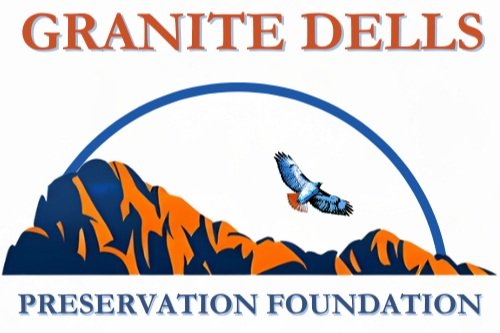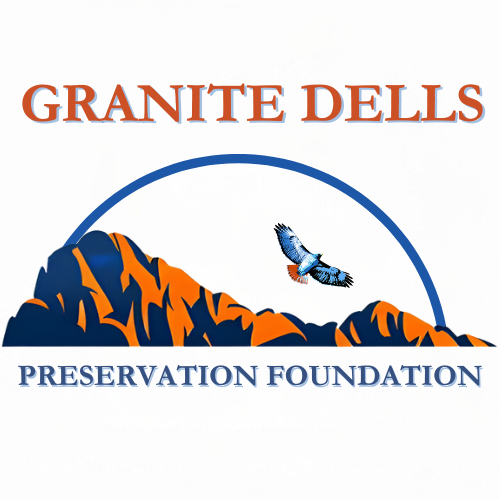Wild Wednesday. 8 December 2021. Gangs, Rings, and Hoodoos, by Walt Anderson
You may look at me funny when I tell you that the Granite Dells is famous for its gangs, rings, and hoodoos, but it’s true. I’m not referring to organized-crime rings or the early gangs of hoodlums who ambushed steam-powered trains on their way through the battlements of Dells outcrops. Those did exist, but they’re history. What I am talking about is prehistory—the amazing rock formations that make the Granite Dells so different from all the other granite formations I am familiar with in Arizona.
Let’s venture into the Dells and see what I am talking about.
I was so lucky to capture this magical light at sunset during a monsoonal storm in the Dells. Actually, it was more than luck, as I drove from near Thumb Butte where I lived to the Dells because I sensed from impending weather that something good could develop. This was no accident.
Part of the charm of the Granite Dells, regardless of light conditions, comes from the unusual rock formations. When rocks are stacked vertically like these, it is very easy to imagine them as ancient people frozen for all time. An artist friend painted this very scene with subtle faces, a sort of low-key Mt. Rushmore effect.
A hoodoo is a tall, thin spire or column of rock, typically in arid country. Bryce Canyon is one of the most notable places to witness hoodoos. However, there are plenty in the Granite Dells, some solitary like this one . . .
. . . and some in pairs or even gangs. I can imagine this stone-faced character saying “Hoo do you do?” to its companion. All right, once in a while you can set aside gravity for a little levity and let your imagination fly.
Roswell may not have been the only place where extraterrestrials landed. By now, this one has become ultraterrestrial. And fat!
When it comes to gangs and rings, there is a special rock formation here called Liesegang Rings.
Sometimes they are more-or-less concentric circles like this.
And sometimes they are weird polygons like these near Willow Lake.
On occasion, the rings go wild, like a thousand church bells chiming simultaneously. Cacophonous ringtones!
These bizarre and spectacular formations are reason enough why we must save as much as possible of the Granite Dells for a greater regional park and preserve! Of course, there are many ecological justifications that compound that desirability for protection.
Liesegang Rings can be found in a variety of rocks (“The Wave” in Paria Canyon is sculpted Navajo Sandstone whose waves are expansive Liesegang Rings). They can be reproduced in the lab through chemical experiments, though what you see in nature can seem to defy the simple patterns you can induce in a lab. They were first described scientifically by a German photographer and chemist named Raphael Edouard Liesegang in 1896. In this sense, he was the ringleader (rädelsführer).
Remember that these granitic rocks formed at great depth as an initial pluton some 1.4B years ago. That’s “B” as in “billion.” Over vast amounts of time, groundwater moved through the rock structure, especially along fractures, and when it hit a change in pH or a redox interface (sudden intersection of reducing and oxidizing conditions), iron oxides precipitating out as “rings.” If this had taken place completely without oxygen, the iron would have made ferrous wheels instead.
This may have played out as repeated precipitation events over millennia (in other words, millennial generation). This pluton was no simple beaker in a chemistry lab! It was a circus of countless rings that were expressed in forms both conceivable and inconceivable (well, inconceivable only to us mortals; obviously they were conceived, as they exist).
Sometimes the rings are hidden in the rocks themselves, only to be exposed when a slab falls off.
Sometimes tinajas form in the fracture lines, little temporary aquatic ecosystems which, if large enough, can be the nursery pools for Canyon Treefrog tadpoles.
To me, Liesegang Rings are some of nature’s most creative art forms.
A walk through the Granite Dells presents lithographic masterpieces in surprising places. This is really a superlative landscape of national park quality. Sedona has nothing on the Granite Dells in terms of geologic beauty. But because this is a small range right next to a growing metropolis, it has too long been taken for granite (sorry about that; just take my jokes with a grain of basalt). That has really changed in recent years as Save the Dells and the Granite Dells Preservation Foundation have increased public awareness and engagement. The Dells is finally getting the public and political recognition it deserves!
I commend the City of Prescott for recent acquisitions that have removed the risk of development from some important areas in the Dells. Previous councils were not always on top of this.
Our parks department has a wonderful trail network, and they are aware that they shouldn’t overdo it; wildlife needs some secluded places for peace, too. As development more and more creates an island effect for the Dells, it is imperative that we allow for animal movements—wildlife corridors that are effective. Too many deer, javelinas, raccoons, raptors, and other wildlife are becoming victims of the high-speed highways all around the Dells, and each collision puts people at risk too. We need to plan wisely for smart and compassionate co-existence!
Enough said.




